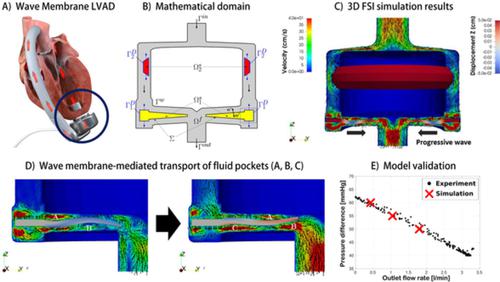当前位置:
X-MOL 学术
›
Int. J. Numer. Method. Biomed. Eng.
›
论文详情
Our official English website, www.x-mol.net, welcomes your
feedback! (Note: you will need to create a separate account there.)
Extended finite element method for fluid-structure interaction in wave membrane blood pump
International Journal for Numerical Methods in Biomedical Engineering ( IF 2.2 ) Pub Date : 2021-04-22 , DOI: 10.1002/cnm.3467 Marco Martinolli 1 , Jacopo Biasetti 2 , Stefano Zonca 1 , Luc Polverelli 2 , Christian Vergara 3
International Journal for Numerical Methods in Biomedical Engineering ( IF 2.2 ) Pub Date : 2021-04-22 , DOI: 10.1002/cnm.3467 Marco Martinolli 1 , Jacopo Biasetti 2 , Stefano Zonca 1 , Luc Polverelli 2 , Christian Vergara 3
Affiliation

|
Numerical simulations of cardiac blood pump systems are integral to the optimization of device design, hydraulic performance and hemocompatibility. In wave membrane blood pumps, blood propulsion arises from the wave propagation along an oscillating immersed membrane, which generates small pockets of fluid that are pushed towards the outlet against an adverse pressure gradient. We studied the Fluid–Structure Interaction between the oscillating membrane and the blood flow via three-dimensional simulations using the Extended Finite Element Method (XFEM), an unfitted numerical technique that avoids remeshing by using a fluid fixed mesh. Our three-dimensional numerical simulations in a realistic pump geometry highlighted, for the first time in this field of application, that XFEM is a reliable strategy to handle complex industrial problems. Moreover, they showed the role of the membrane deformation in promoting a blood flow towards the outlet despite an adverse pressure gradient. We also simulated the pump system at different pressure conditions and we validated the numerical results against in-vitro experimental data.
中文翻译:

波膜血泵流固耦合的扩展有限元法
心脏血泵系统的数值模拟是设备设计、液压性能和血液相容性优化不可或缺的一部分。在波膜血泵中,血液推进产生于波沿振荡浸入式膜的传播,产生小袋流体,逆着不利的压力梯度被推向出口。我们使用扩展有限元方法 (XFEM) 通过三维模拟研究了振荡膜与血流之间的流体-结构相互作用,这是一种未拟合的数值技术,可通过使用流体固定网格来避免重新划分网格。我们在真实泵几何结构中的三维数值模拟首次在该应用领域强调了 XFEM 是处理复杂工业问题的可靠策略。而且,他们展示了膜变形在促进血液流向出口的作用,尽管存在不利的压力梯度。我们还模拟了不同压力条件下的泵系统,并根据体外实验数据验证了数值结果。
更新日期:2021-04-22
中文翻译:

波膜血泵流固耦合的扩展有限元法
心脏血泵系统的数值模拟是设备设计、液压性能和血液相容性优化不可或缺的一部分。在波膜血泵中,血液推进产生于波沿振荡浸入式膜的传播,产生小袋流体,逆着不利的压力梯度被推向出口。我们使用扩展有限元方法 (XFEM) 通过三维模拟研究了振荡膜与血流之间的流体-结构相互作用,这是一种未拟合的数值技术,可通过使用流体固定网格来避免重新划分网格。我们在真实泵几何结构中的三维数值模拟首次在该应用领域强调了 XFEM 是处理复杂工业问题的可靠策略。而且,他们展示了膜变形在促进血液流向出口的作用,尽管存在不利的压力梯度。我们还模拟了不同压力条件下的泵系统,并根据体外实验数据验证了数值结果。











































 京公网安备 11010802027423号
京公网安备 11010802027423号